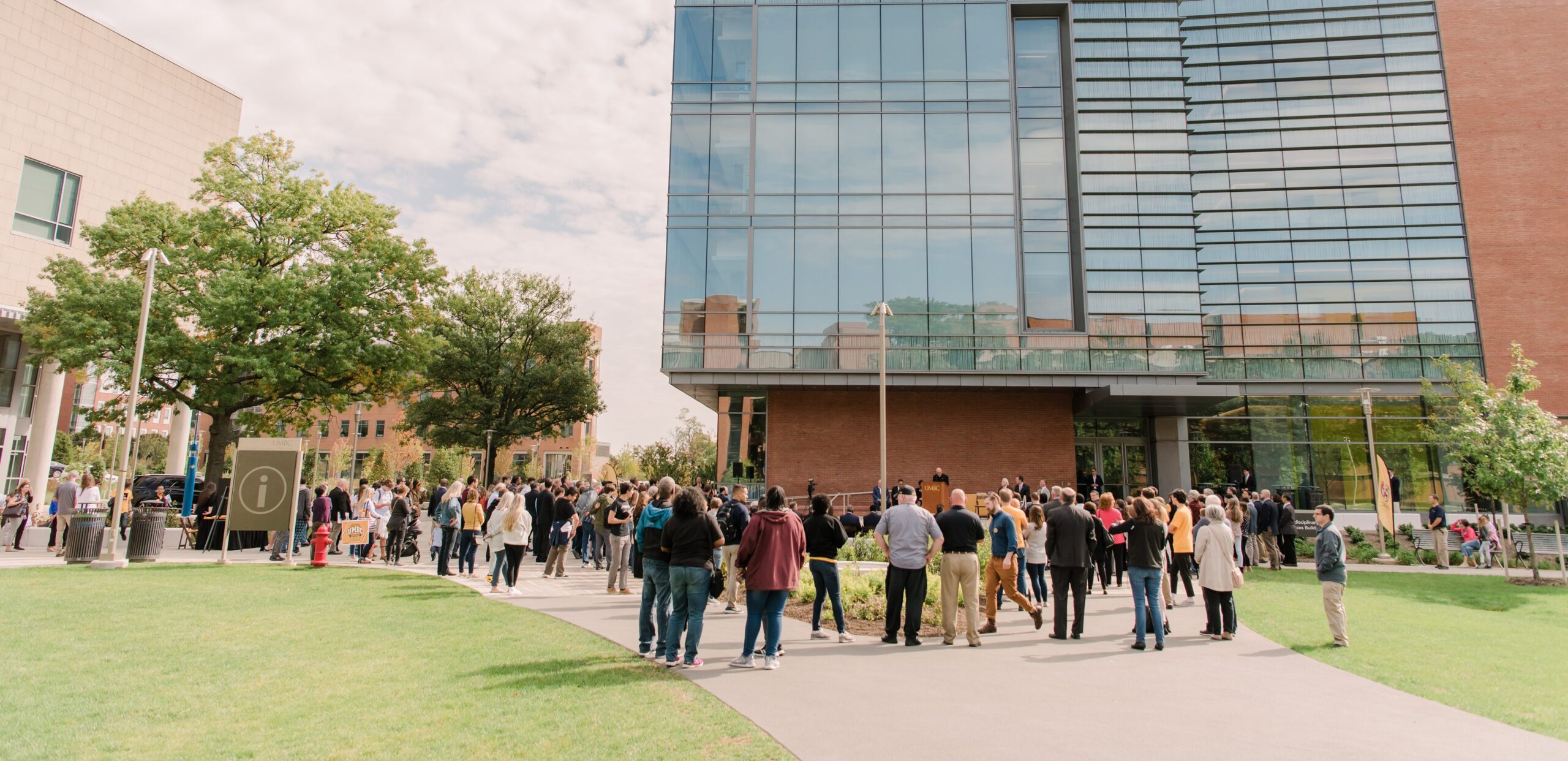During the height of UMBC Homecoming festivities on October 12, the university community and supporters from across Maryland gathered to celebrate the opening of UMBC’s Interdisciplinary Life Sciences Building (ILSB). “With the addition of this incredible, world-class facility, the state of Maryland will continue to lead the way,” Governor Larry Hogan told the crowd, speaking from behind a festive ribbon twisted in the form of a double helix . “And UMBC will continue to push the boundaries, achieve significant breakthroughs, and shine as a national and global leader in innovation.”
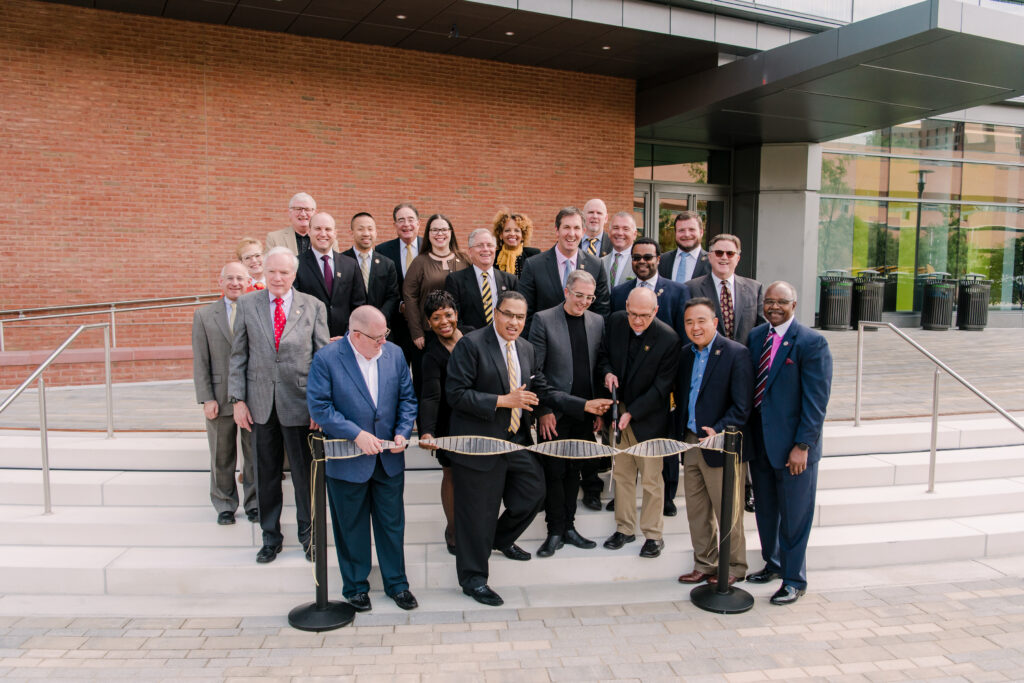
Vision for the future
When thinking about how this building came to be, Bill LaCourse, dean of the College of Natural and Mathematical Sciences, sees convergence—people and ideas coming together from different directions to create something new and meaningful—as the central concept.
“Already there are research teams working in this building on such complex issues as age-related disease, environmental degradation, and health disparities,” he notes. Why these topics? Solutions to our most complex challenges “are found through a convergence of talent and effort,” bringing together the perspectives of people from different fields and backgrounds, he shared at the opening event. This is what the new building is designed to achieve.
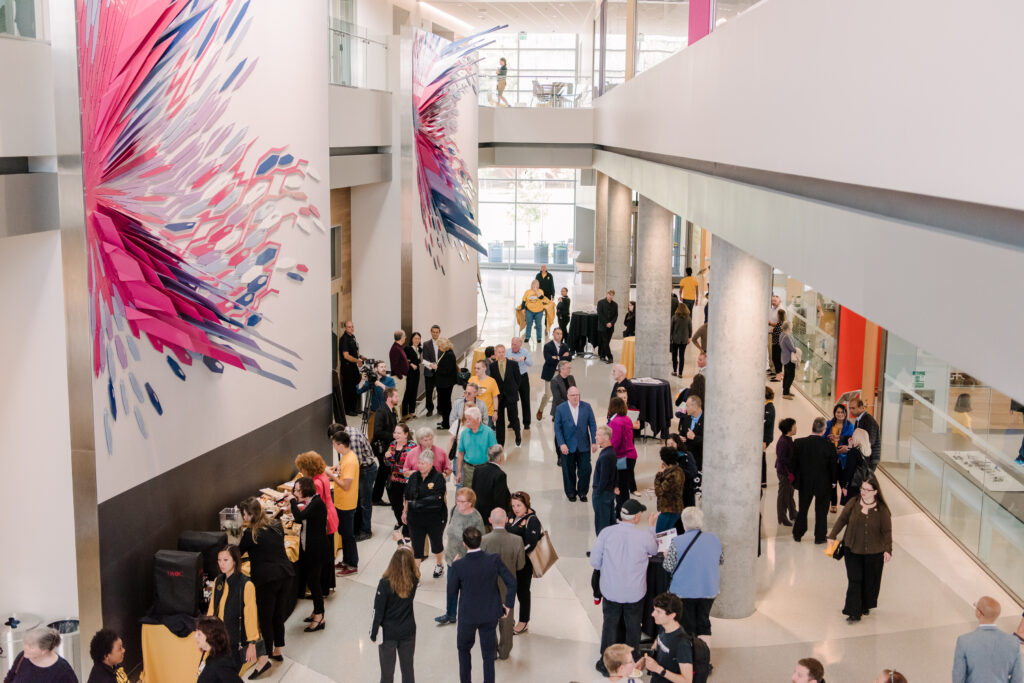
The ILSB is a physical space where people from all over UMBC converge to learn and discover, and it was developed with that goal in mind. “This was a shared effort,” LaCourse said. “This building belongs to everybody on this campus.”
But the benefits of the building will extend far beyond those who study, experiment, and collaborate inside it. “The vision is that we prepare the citizens of this state for the workforce, so everybody has a better life,” shared UMBC President Freeman Hrabowski. “This building will lead to so many people in science, in engineering, and in medicine, saving lives. And it’s that vision I want everyone to think about.”
Alumni leaders reflect
In addition to Governor Hogan, several local and state leaders, who are also UMBC alumni, joined in to celebrate what the new building represents: UMBC’s investment in inclusive, problem-oriented, team-based approaches to teaching and research that will also support economic and workforce development in the state.
Baltimore County Executive John “Johnny O.” Olszewski, Ph.D. ’17, public policy, lauded the numerous and diverse UMBC graduates who go on to own local STEM-oriented businesses and employ other Marylanders. “UMBC is a special place, and I couldn’t be prouder to have a degree from this incredible institution,” he added.

Maryland Speaker of the House Adrienne Jones ’76, psychology, also expressed her appreciation for UMBC. “UMBC is really setting the bar high in terms of science, and I commend you for what you continue to do,” she shared. “I’m proud to be an alumna.”
Alumni delegates Mark Chang ’99, psychology, and Charles Sydnor III ’00, policy sciences, also attended. Senate President Mike Miller gave remarks, as did Ken Skrzesz, executive director of the Maryland Arts Council, which supported the construction of the ILSB’s public art installation.
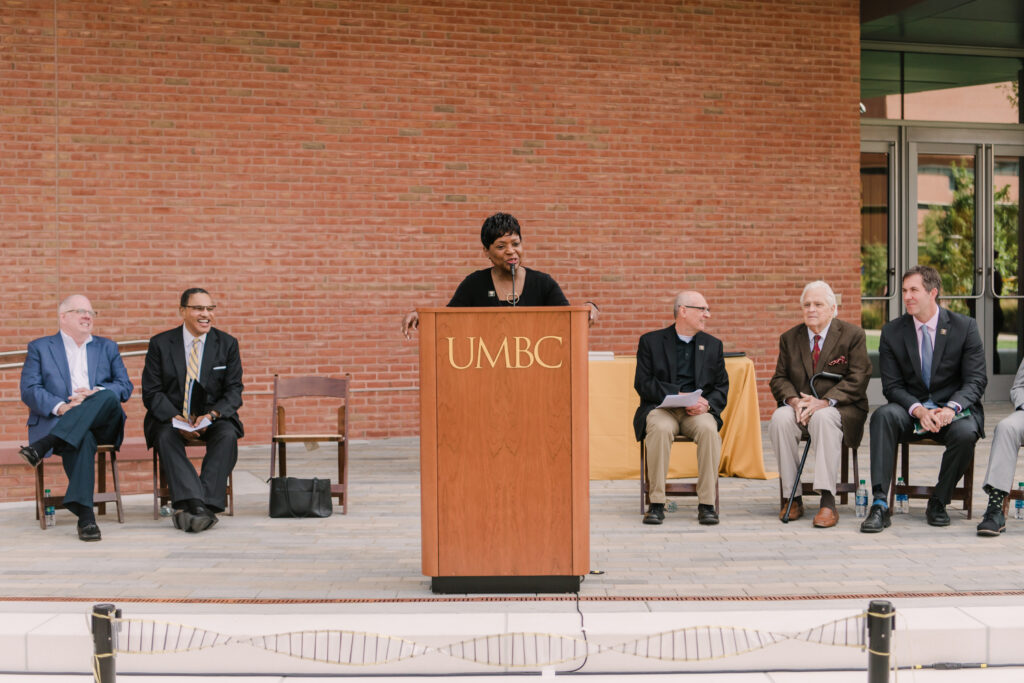
Environment for growth
Following the ribbon-cutting ceremony, the ILSB opened for building tours and hands-on, family-friendly science activities in the teaching labs, including making slime and using microscopes. The building also hosted an active learning demonstration in a tech-enabled classroom and UMBC’s fourth annual GRIT-X talks.
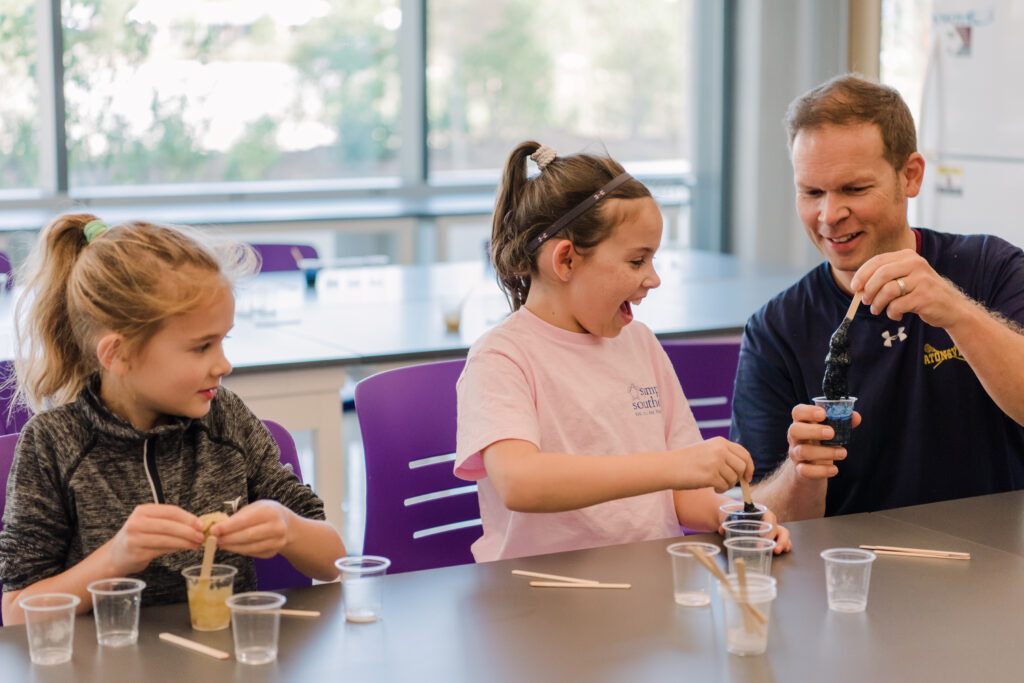
Nine GRIT-X speakers shared their stories of discovery, creativity, collaboration, and perseverance with a standing-room-only crowd in the ILSB. They included two alumni, six faculty members, and one graduate student, representing all three UMBC colleges.
Crystal Watkins-Johannson ’95, M3, biological sciences, reflected on how her experience at UMBC shaped her future. Today, she combines her expertise in neuroscience with her passion for education and patient care as director of the memory clinic in the Sheppard Pratt Health System and assistant professor of psychiatry and behavioral sciences at Johns Hopkins University.
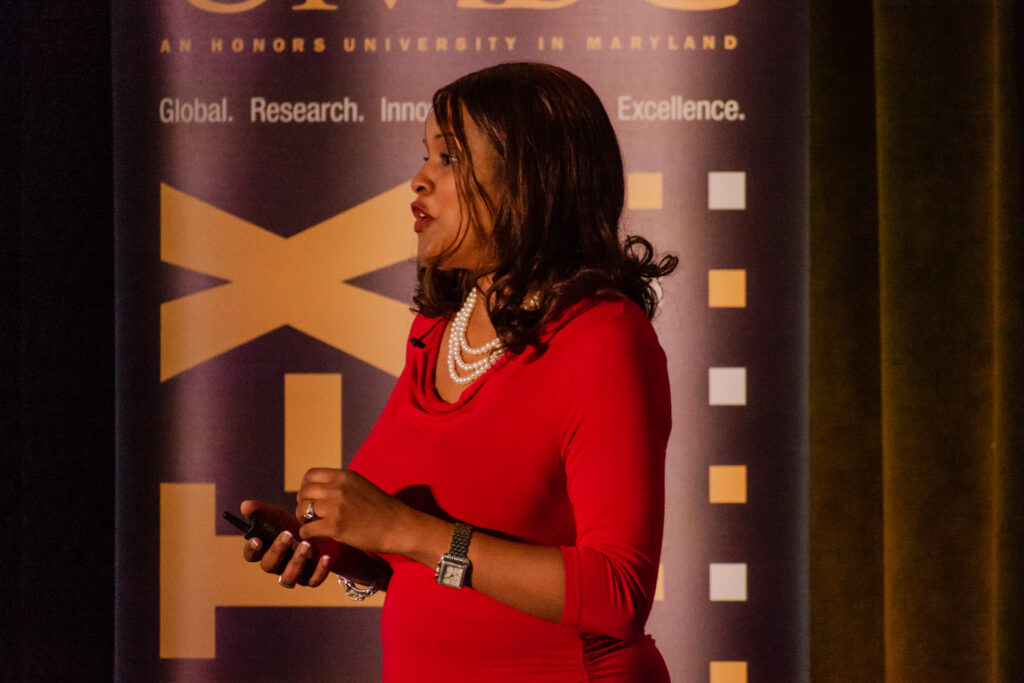
“I’d always felt like I was different, but when I came to UMBC for the accepted Meyerhoff Scholars weekend, everyone around me had accomplished just as much as I had,” Watkins-Johannson shared. “It really inspired me that I was going to have an environment that would allow me to grow, think about new ideas, and propel me to the next step.”
Today, she uses the grit she internalized at UMBC to help her patients with memory loss. “I’m able to help other people look at memory loss and persevere through it,” she says.
Empowering experiences
Fellow alumnus Premal Shah ’98, biochemistry and molecular biology, earned his Ph.D. in biochemistry and molecular biophysics at Caltech, and then launched a career as a socially-conscious entrepreneur. In 2018, he co-founded Citizen, a company that helps people access their healthcare data for free. The goal is to improve health outcomes by empowering people to take a more active role in their healthcare.
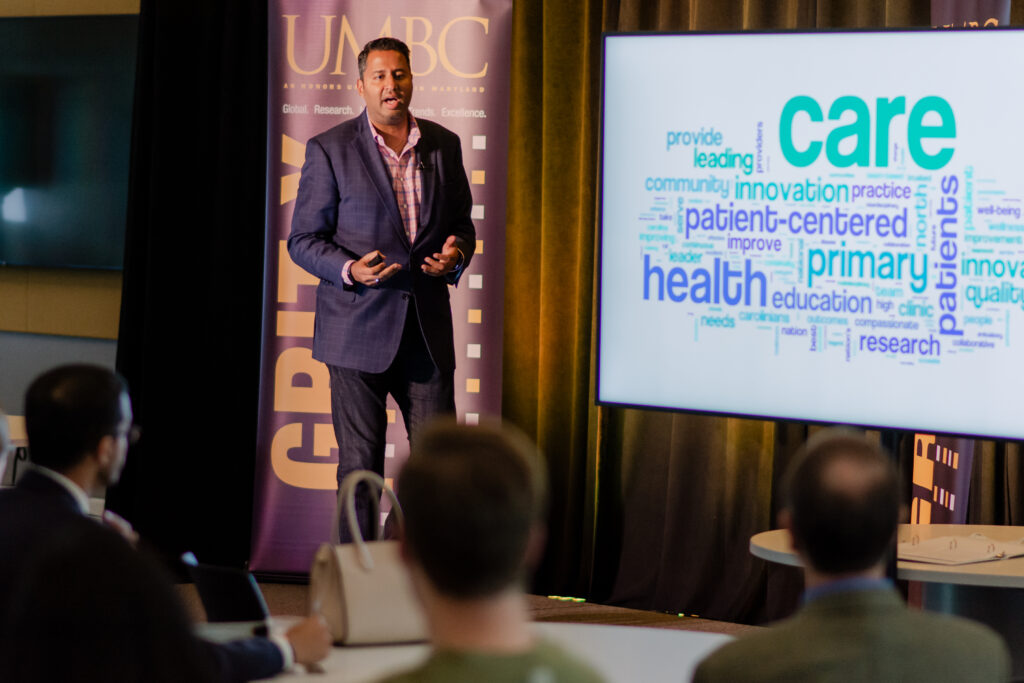
Like Watkins-Johannson, Shah’s UMBC experience was pivotal in his development. “I want to emphasize that I’ve been fortunate enough to have very good people in my life,” he shared at GRIT-X. “People who have taken an interest in me, people who have cared about me, people who’ve shown me the difference between right and wrong—and therefore I’ve been able to achieve what I have in my career.”
Other speakers included Kevin Omland, professor of biological sciences; Tinoosh Mohsenin, associate professor of computer science and electrical engineering; Lisa Moren, professor of visual arts; Mustafa Al-Adhami, Ph.D. ’20, mechanical engineering; Greg Szeto, assistant professor of chemical, biochemical, and environmental engineering; Carolyn Forestiere, associate professor of political science; and Yonathan Zohar, professor of marine biotechnology. Their talks covered a range of topics including the value of study abroad experiences, sustainable aquaculture, artificial intelligence, and the need for diversity among scientists.
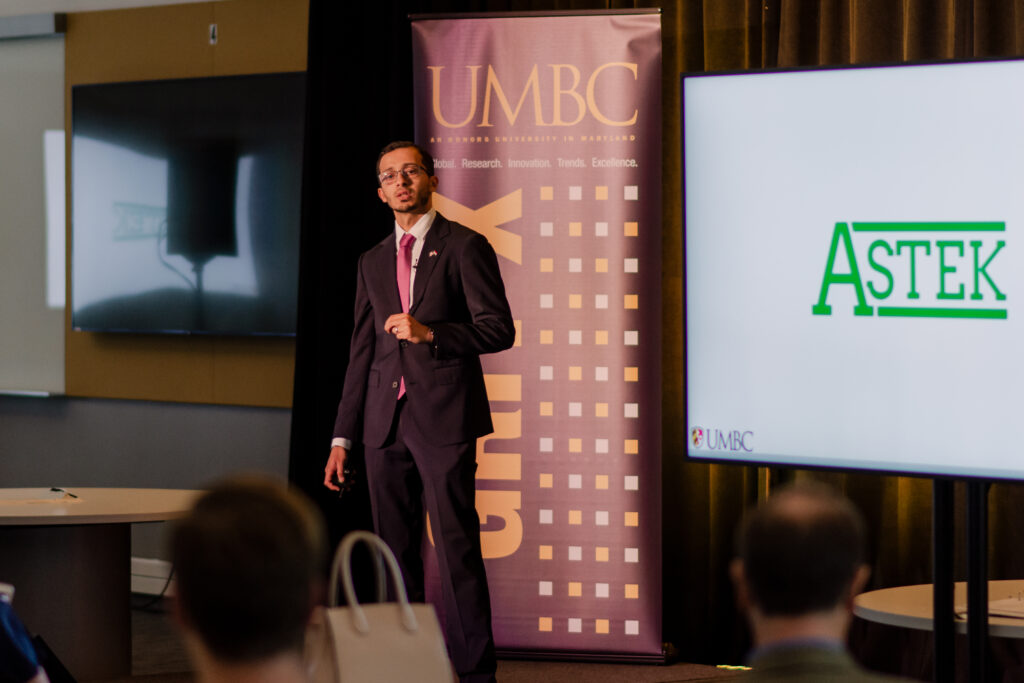
At the ribbon-cutting, President Hrabowski reflected on the broad and impactful work members of the UMBC community have already accomplished, and which the ILSB will continue to support for current and future Retrievers.
Whether it’s changing the world through research or training the next generation, “When you have a great goal, it’s important to build a large and diverse community,” to work toward that goal, Hrabowski said. “This building is really teaching us the power of convergence.”
Banner image: Supporters gather outside the ILSB in advance of the ribbon-cutting ceremony. All photos by Marlayna Demond ’11 for UMBC unless otherwise noted.
Tags: Biology, CAHSS, CBEE, ChemBiochem, CNMS, COEIT, grit-x, Hrabowski, MarineBiotech, MechE, PoliticalScience, Psychology, PublicPolicy, visual arts

